Centenary of the Census of Agriculture
Census of Agriculture celebrates its 100th anniversary portraying the history of the sector in the country
September 01, 2020 01h00 PM | Last Updated: September 08, 2020 12h42 PM
Highlights
- First conducted in September 1920, the Census of Agriculture is the main and most comprehensive statistical and territorial survey on Brazilian agricultural production.
- The information produced by the survey makes it possible to plan and assess public policies in the sector.
- In the period of 100 years, the Census of Agriculture has followed the technological change in farming and has also been modernized.
- The first Census of Agriculture was conducted by the General Statistics Directorate - DGE, a body of the former Ministry of Agriculture, Industry and Trade. After this pioneering operation, there were 10 more editions, the last one in 2017, totaling 11 Censuses.
- In the 2006 Census of Agriculture, electronic data collection devices - PDA (Personal Digital Assistant) were used for the first time, replacing paper questionnaires and collecting the geographical coordinates of agricultural establishments.
- In the 2017 edition, Mobile Collection Devices (DMC) were used, in which there were the previous address files and georeferenced systems.
- The Family Agriculture Law, 2006, was established based on a methodology developed by researchers from the Federal Fluminense University (UFF) for the Census of Agriculture to portray family agriculture more adequately.
From a family establishment of tomato farming in a rural area of a small town to a big cattle raising farm: nothing escapes the Census of Agriculture. The reality of the countryside is portrayed by the survey that goes on 100 years old this Tuesday (Sept 1). The Census of Agriculture is the main and most comprehensive statistical and territorial survey on the Brazilian agricultural production, covering information on the structure, dynamics and production level of this economic activity in Brazil.
The information produced makes it possible to plan and assess public policies in the sector, as for instance, the land distribution issue. The results also support studies on the expansion of agricultural areas and the producing dynamics propelled by technological innovations; moreover, they contribute to the construction of environmental indicators, while providing analyses on the changes occurred due to economic reestructuring and adjustments, as well as their effect on the sector.
The first Census of Agriculture was conducted by the General Statistics Directorate - DGE, a body of the former Ministry of Agriculture, Industry and Trade. After this pioneering operation, there were 10 more editions, the last one in 2017, totaling 11 Censuses of Agriculture. The IBGE has been in charge of the operation since the foundation of the Institute in 1936. “And in all those years the IBGE has been present and taken part in the transformations, providing quality data for more and more efficient and effective goals and public policies”, recognizes the Minister of Agriculture, Livestock and Supply, Tereza Cristina, who sent a congratulatory note to the IBGE.
Authorities and organizations of the sector congratulate the IBGE for the Census of Agriculture's centenary:
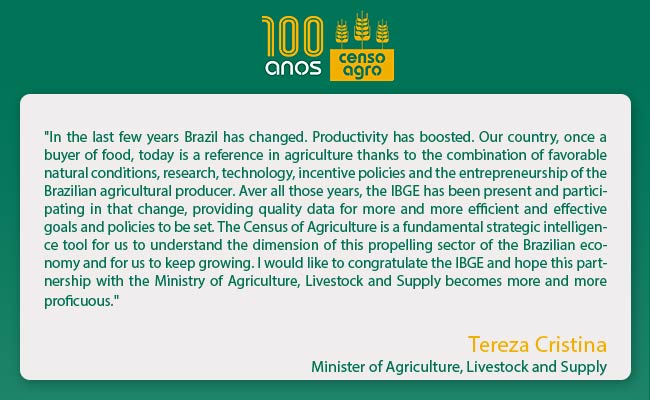
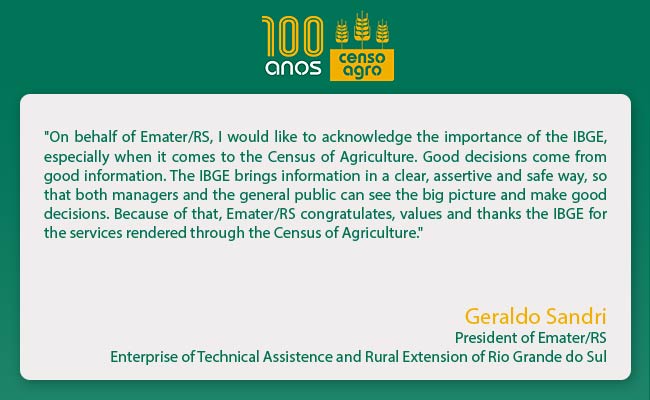
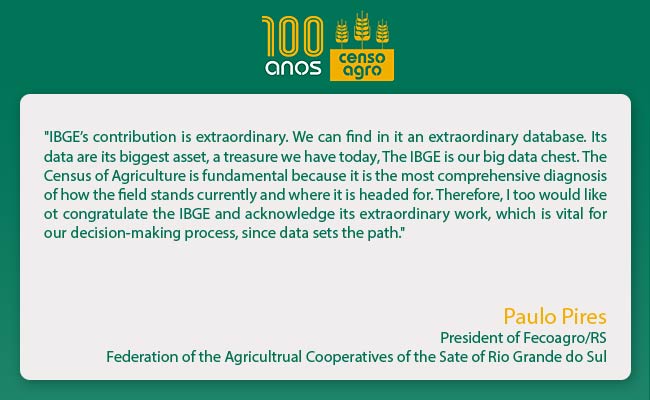
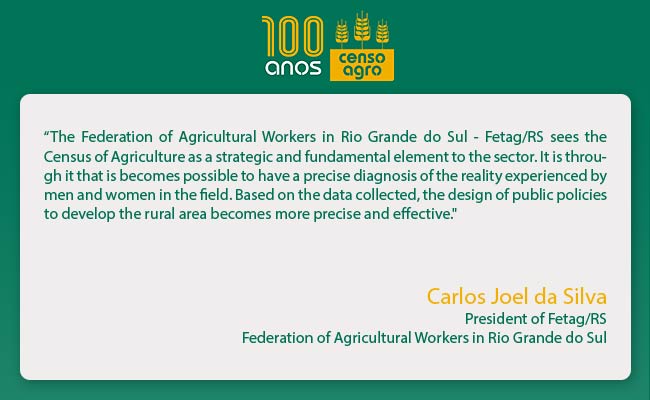
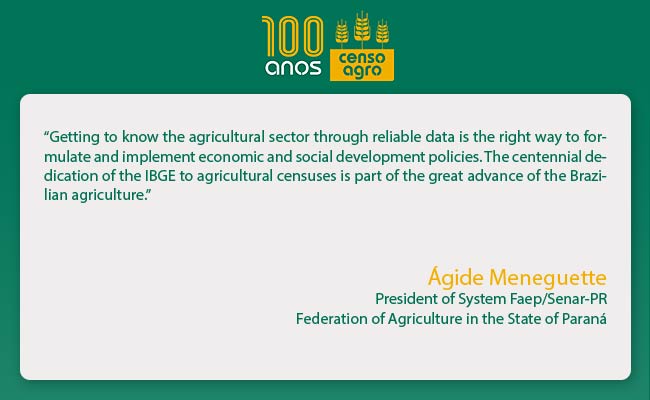
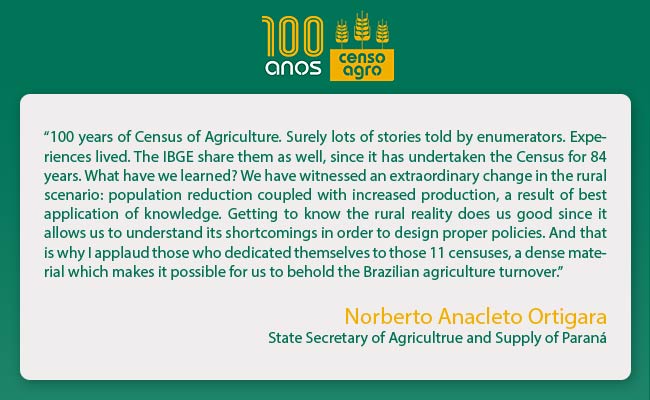
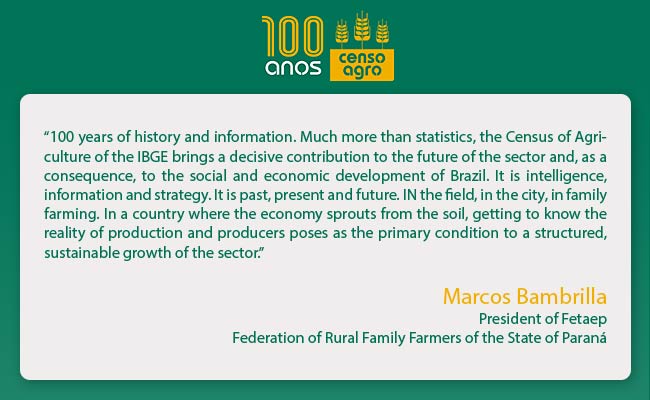
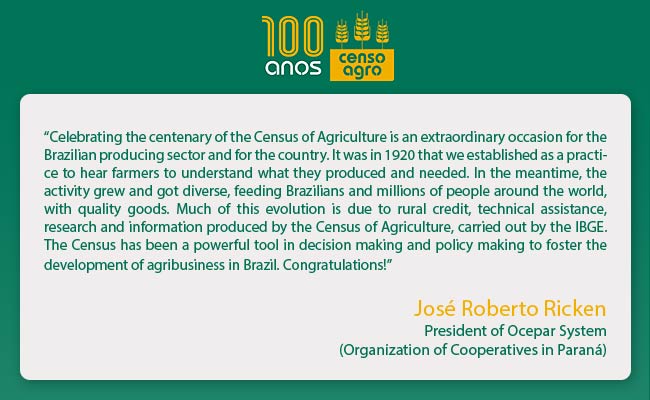
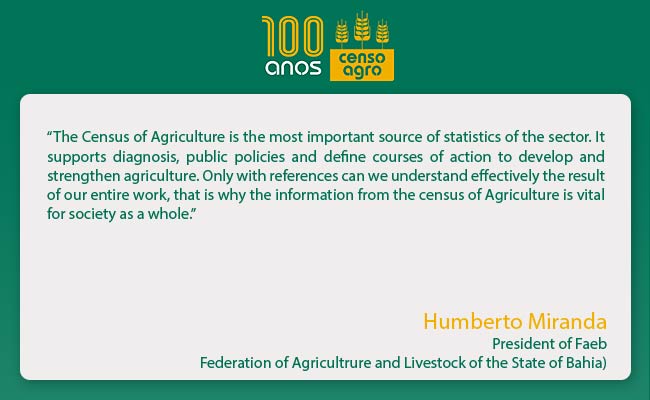

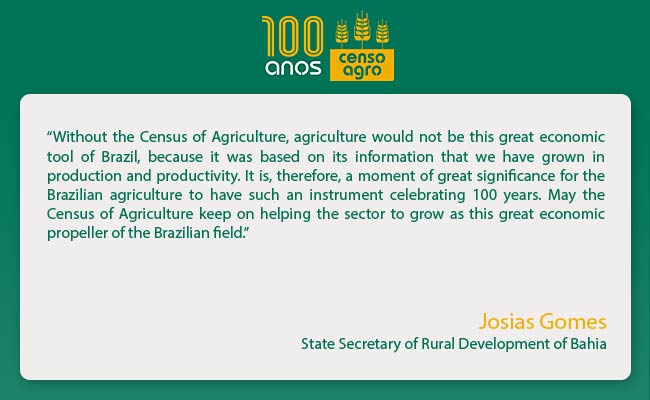

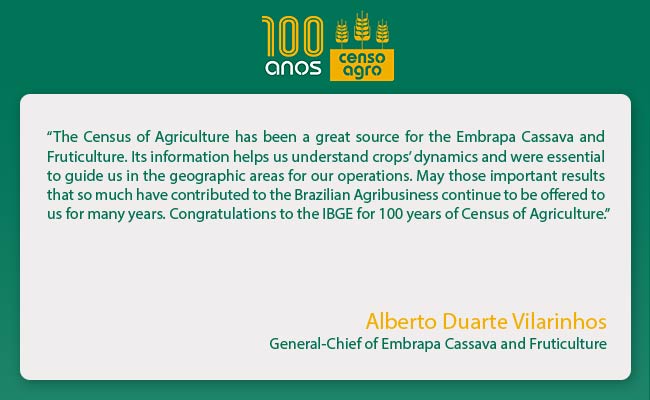
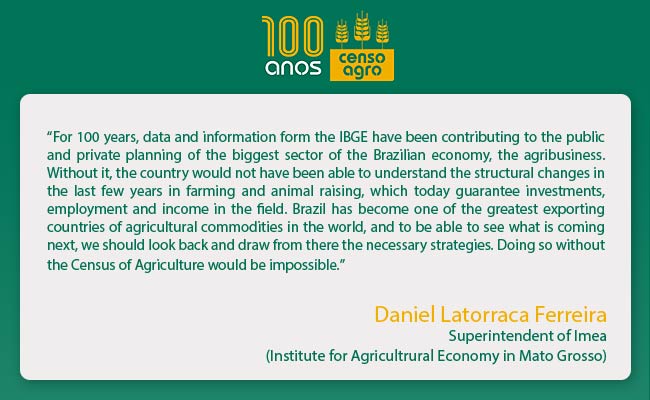
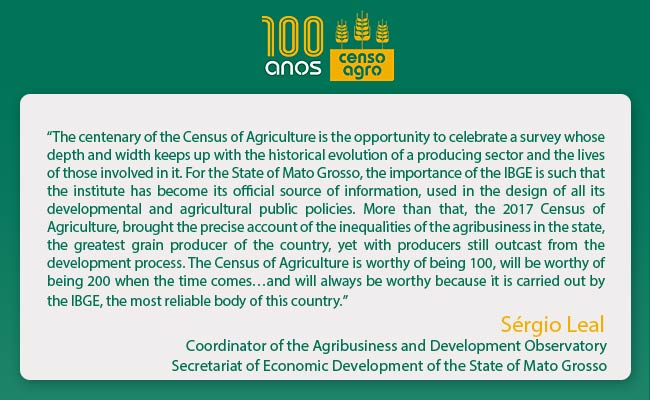
Within this period of 100 years, the Census of Agriculture was always in line with the technological changes in farming and has become modern too – either in the themes addressed and in the technologies used today for the survey conduction. In the decade after the first survey, due to the political issues that culminated in the Revolution of 1930s, the Census of Agriculture was not carried out. “As of the 1940s, it became a decennial survey. In 1970, it was carried out every five years, with editions in 1970, 1975, 1980 and 1985. It should have gone on like this, but as of 1985, there were financial issues that compromised the process. So, it was carried out just in 1995-1996, 2006 and 2017”, says Anntonio Carlos Florido, IBGE retired researcher, who stood ahead of the Census of Agriculture in its last three editions.
Mr. Florido started working in the Agri Census at the age of 25, as soon as he started at the IBGE, in 1977. The 1975 edition was at the beginning of the counting phase. “Basically, when I joined the IBGE, the questionnaire was in paper, it was hard work because all the material was collected and brought to Rio de Janeiro, so it took from five to six years to release the results. In the 1995 Census, although the questionnaire was still in paper, there was a big advance with the counting decentralization, which was done in locally in each state simultaneously”, recollects Mr. Florido.
The changes in the Census of Agriculture were also witnessed by José Renato Braga de Almeida, today ahead of the IBGE State Branch in Rio Grande do Sul. “In 1980, we coordinated the Population Census and right after that the Census of Agriculture. Ever since, I have participated in five Censuses of Agriculture. During this time, we have undergone several changes in the collection phases of the censuses in the IBGE, changes fit to their respective periods. With the great computer revolution taken place in the IBGE as of the 2000 Population Census, in the edition of the 2006 Census of Agriculture, coupled with the population count, the PDA was used for the first time in collection”, Mr. Almeida recollects.
The PDA (Personal Digital Assistant) replaced paper questionnaires. By using this digital collector with geographic coordinates, paper was left aside. It was an unprecedented achievement among the countries, even among those more technologically advanced.
The experience was repeated in 2017 and followed by other countries, especially in Latin America, which, by the way, visited us during the collection phase to get familiar with the procedures used by the IBGE in order to apply them to their own operations.
“We had also the inclusion of new themes, as for instance, questions about the environment, irrigation and use of herbicides”, says Mr. Almeida. “But the big methodological and technological change happened in the 2017 Census of Agriculture, especially due to the methodology and maturation time”, completes the researcher.
After joining the IBGE, the current head of the Bahia State Branch, Artur Ferreira, was a technical coordinator of the state for the Censuses of Agriculture of 75 and 80. “The main goal of the Census of Agriculture has always been to monitor the farming structure of Brazil. As the agricultural production is developed in the rural areas, which used to be very poorly known, just the Census of Agriculture accounted for that. The data demand was enormous and, therefore, it became a survey carried out every five years”, says Mr. Ferreira, highlighting the innovation brought by the 1995/1996 Census, which considered the agricultural year instead of the civil year, used before that.
Although giving emphasis to the technological innovations brought by the 2006 Census, Mr. Ferreira is convinced that the biggest changes came up in the last edition. “The Census’ results were put out in less than two years, much less than it used to take. Even when it took long, the information was essential, and all agricultural agencies demanded much of it. Today we can count on very recent data” claims Mr. Ferreira.
Antonio Carlos Florido also stresses that, among the innovation brought by the Agri Census of 2017, are the use of the Mobile Collection Device (DMC), previous address file and collection in special establishments, as well as an immense use of georeferenced systems.
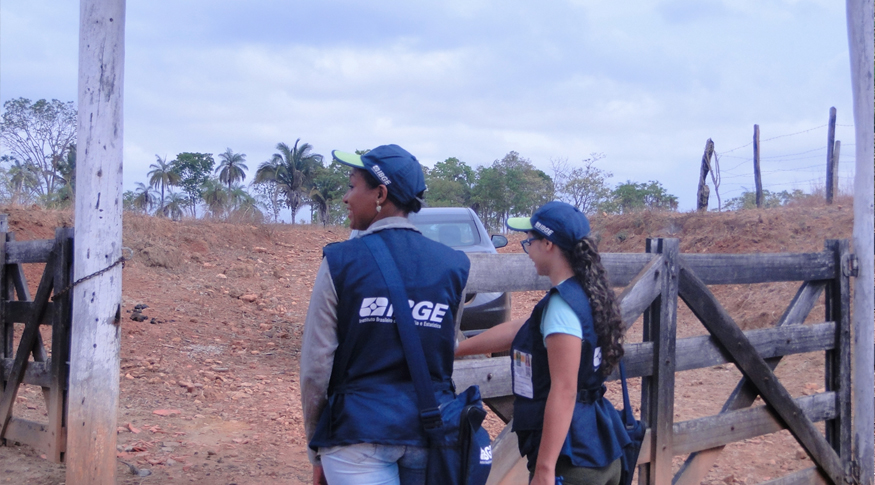
A portrait of the field
“Each edition of the Agri Census depicts the field at a certain moment of time. Therefore, it has witnessed its entire evolution, including the technological advance, innovations and productivity increase”, claims Mr. Florido. “The census helps to design public policies and monitor the evolution in time of this social category that we suppose to be relevant to the country”, says the professor of the Federal Fluminense University (UFF), Dr. Carlos Enrique Guanziroli.
As of 1994, he coordinated a team that designed a methodology for the Census of Agriculture to capture as adequately as possible the family farming reality. The study originated a document named “The new portrait of family farming in Brazil”, which was the base for the establishment of the Family Farming Law, of 2006.
For Mr. Almeida, the information collected in the Census of Agriculture are crucial for the understanding of an economic activity which is present all over the country. “This activity undergoes profound changes in few time, whit fast alterations in the goods produced, in the production way, the use of labor force, use of technology, an impact on soil and environment”, he claims.
According to researcher Nelson Senra, the transformations of the Agri Census are another of the Institute’s characteristics. “The IBGE is connected and in line with what is best out there. It could not be otherwise with the Agri Census. As a new theme aroused, it would be included in the Census, if something else would not fit in any longer, it would be discharged with no hesitation”, he concludes.
Head of the IBGE State Branch in Paraná, Sinval Dias dos Santos endorses the importance of the Census of Agriculture all over Brazil, mentioning gratefully the good partner agricultural entities in his state. “Especially in the 2017 Census of Agriculture, the most recent one, when the great event to disclose the final data, held here in Paraná, received 18 local and national media representatives”.
The Censuses of Agriculture conducted by the IBGE follow, traditionally, the technical recommendations of the United Nations Food and Agriculture Organization – FAO, allowing, thus, international comparability. Brazil has participated in regional meetings held by FAO and in international congresses of agricultural statistics, sharing experiences.
The legacy of Manoel Antônio Soares da Cunha
When Mr. Florido started in the IBGE, Manoel Antônio Soares da Cunha was ahead of the survey. “He got in in 1950 as an enumerator for the Agri Census and went on rising until he became a coordinator’, says Florido, who replaced him in the Coordination of the Census of Agriculture as of 1991. “For a long time, Manoel Antônio Soares da Cunha has been a synonym for Agri Census”, claims researcher Mr. Senra, who dedicated to Mr. Cunha the book “O Censo entra em campo (The Census goes in the field)”, telling the history of agricultural enumerations.
“He was not afraid of renewal. Thanks to him, the Agri Census would bring, at each new edition, timely changes. He was able to give his very best. Actually, beyond his dedication to the agricultural surveys, mainly the Agri Census, he was very attentive to all the areas in the IBGE”, says Mr. Senra about Mr. Cunha, stressing his good memory and good humor. In 2019, Mr. Cunha passed away.
Please, click here to read IBGE’s highlight on the 100th anniversary of the Census of Agriculture.




















